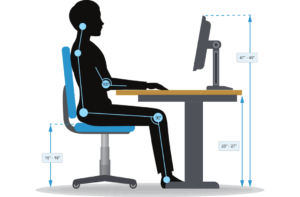Ergonomics and Sport: Optimizing Performance and Preventing Injuries

In the world of sports, athletes continually strive to push the boundaries of human performance. Whether it’s running faster, jumping higher, or throwing farther, athletes are always looking for ways to gain a competitive edge. One often overlooked factor in achieving peak performance and preventing injuries is ergonomics. Ergonomics, the science of designing environments and products to fit the people who use them, plays a crucial role in optimizing athletic performance and reducing the risk of injuries. In this article, we’ll explore the relationship between ergonomics and sport and discuss how athletes can leverage ergonomic principles to achieve their full potential.
1. Understanding Ergonomics in Sport
Ergonomics in sport involves designing equipment, facilities, and training programs to enhance athlete performance while minimizing the risk of injuries. It encompasses a range of factors, including biomechanics, anthropometry, physiology, and psychology, to create environments that are conducive to optimal performance and well-being.
By applying ergonomic principles to various aspects of sport, athletes can improve their technique, efficiency, and overall athletic ability, leading to better results on the field, court, or track.
2. Equipment Design and Ergonomics

One area where ergonomics plays a significant role in sport is in the design of athletic equipment. Whether it’s running shoes, tennis rackets, or golf clubs, ergonomically designed equipment can enhance performance and reduce the risk of injuries.
For example, ergonomic running shoes are designed to provide optimal support, cushioning, and stability while promoting a natural gait and foot motion. Tennis rackets with ergonomic handles and grip sizes allow players to maintain a secure grip and generate more power and control on their shots. Golf clubs with adjustable shafts and clubheads enable players to customize their equipment to suit their individual swing characteristics and preferences.
3. Facility Design and Ergonomics
The design of sports facilities also plays a crucial role in athlete performance and safety. Ergonomic principles are applied to the layout, dimensions, surfaces, and amenities of sports venues to optimize conditions for training and competition.
For example, track and field facilities are designed with precise dimensions and surface materials to meet specific performance standards and minimize the risk of injuries. Basketball courts feature shock-absorbing flooring and clear sightlines to enhance player comfort and visibility. Swimming pools are equipped with starting blocks, lane markers, and underwater cameras to facilitate efficient training and competition.
4. Training Programs and Ergonomics
In addition to equipment and facility design, ergonomics also influences the development of training programs and techniques in sport. Ergonomically designed training regimens focus on optimizing movement patterns, reducing fatigue, and maximizing athletic potential.
For example, strength training programs incorporate exercises that target specific muscle groups and movement patterns relevant to the athlete’s sport. Flexibility and mobility drills help improve joint range of motion and reduce the risk of injuries during training and competition. Ergonomic coaching techniques emphasize proper body mechanics, posture, and breathing techniques to optimize performance and prevent overuse injuries.
5. Injury Prevention and Ergonomics

One of the primary goals of ergonomics in sport is injury prevention. By identifying and addressing ergonomic risk factors, athletes can reduce the likelihood of acute injuries, such as sprains, strains, and fractures, as well as chronic overuse injuries, such as tendonitis and stress fractures.
Ergonomic interventions, such as proper warm-up and cool-down routines, adequate rest and recovery periods, and biomechanical assessments, help identify and correct movement deficiencies and imbalances that contribute to injury risk. Additionally, ergonomic equipment, such as protective padding, braces, and compression garments, can help mitigate the impact of falls, collisions, and repetitive motions during training and competition.
In conclusion, ergonomics plays a vital role in optimizing athletic performance and preventing injuries in sport. By applying ergonomic principles to equipment design, facility layout, training programs, and injury prevention strategies, athletes can enhance their technique, efficiency, and overall well-being. Whether it’s running faster, jumping higher, or throwing farther, ergonomics provides athletes with the tools and knowledge they need to achieve their full potential and stay healthy and injury-free throughout their careers. As our understanding of ergonomics continues to evolve, so too will its impact on sport, driving further advancements in athletic performance and safety for athletes of all levels.


